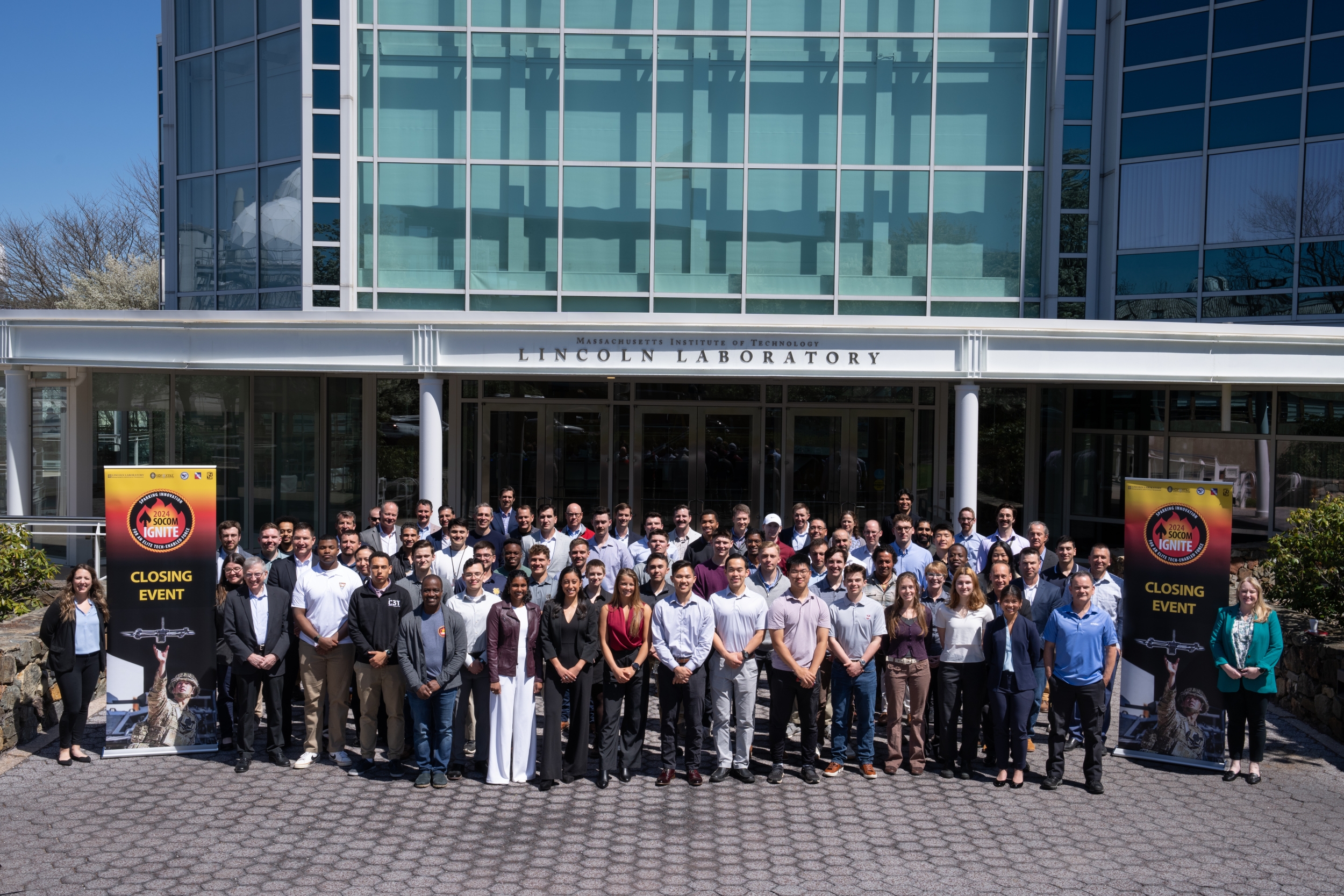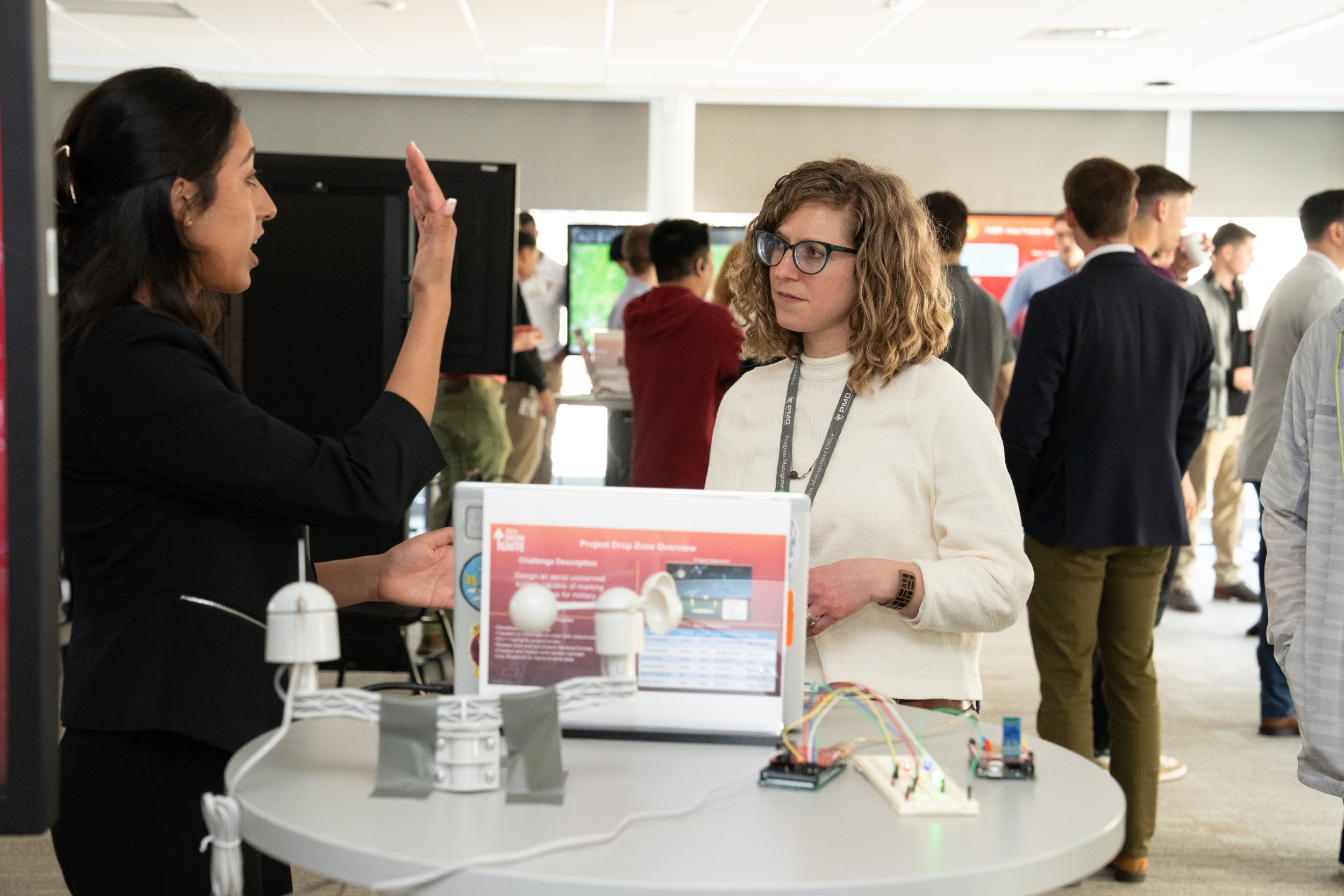
SOCOM Ignite students generate forward-looking prototypes

Throughout the country, cadets have been hard at work turning their ideas into prototypes with real-world impact. They have been testing sensors that monitor human oxygen levels, combining small drones with ground vehicles to make hybrid platforms, and using lidar to autonomously navigate indoors. These ideas and others are coming closer to fruition through the U.S. Special Operations Command (SOCOM) Ignite program.
In SOCOM Ignite, Special Operations Forces (SOF) operators annually outline challenges requiring next-generation technology. Military students then work in teams and with Lincoln Laboratory mentors during the school year to innovate solutions addressing those challenges.
This year’s effort culminated in a closing ceremony on April 25 at Lincoln Laboratory. Thirteen teams presented their solutions to an audience of technical staff, SOF operators, and SOCOM leadership. Following presentations, the students participated in a technical exposition to demonstrate and discuss their developed technology with attendees.
"Today, we saw a full range of capabilities being developed — some of them are in early phases, and some of them are practically ready to field. Some applications are niche, and others are broad. I'm grateful to have the opportunity to put the challenges we face in front of you. The way we inspire solving our problems is by sharing our problems," said Lisa Sanders, director of science and technology for SOF, Acquisition, Technology, and Logistics, SOCOM.
The program, now in its fourth year, kicked off last September. More than 80 students, representing military service academies and Reserve Officers' Training Corps (ROTC) programs nationwide, gathered at the Laboratory to receive the challenges. In hackathon style, they started formulating ideas while SOF operators and Laboratory technical experts fielded questions and provided feedback. The cadets then continued their work back at college, sharing progress updates throughout the year.

William Chu, an Army ROTC cadet from Rutgers University, served as the project lead on one challenge to develop a tool for communicating the medical status of casualties. The system and software his team developed uses artificial intelligence (AI) algorithms, including those for computer vision and speech processing, to automate the documentation process. Such an approach could save combat medics valuable time to perform lifesaving procedures, and allow status information to reach higher echelons of care before a casualty arrives.
During their presentation, the team showed a video demonstrating a medic narrating (into a helmet-mounted microphone) the treatments being administered to a simulated casualty, while imagery from his camera was processed to identify the patient and detect a torniquet.
At the end of the closing ceremony, the casualty status team won the SOCOM Ignite Award for Operational Impact. "The award not only recognizes our efforts but also brings attention to the possibilities of AI technology in emergency medicine for solving crucial issues in medical documentation," Chu said.

Libby Ross, an Air Force ROTC cadet and nursing student at Texas Tech University, also pursued a challenge involving emergency medicine. Her team was tasked with improving the transport and storage of fresh blood in care facilities on the frontlines. Transport boxes used today are bulky and heavy, and can only keep blood viable for a short window of time. Aiming for modularity and adaptability, Ross presented a technique to put blood bags in insulated water bottles. A cooling agent would be added to the water at transport, making instant and replenishable cold packs lasting for several hours.
Other teams took on hardware development to solve communications challenges. One challenge asked for a way to enable operators in small units to communicate without radio frequencies. Jack Regan, an Army ROTC cadet at Worcester State University, and Jacob Brody, an Air Force ROTC cadet at Texas Tech, presented a system that uses shortwave-infrared lasers to communicate, and integrated it into an existing headset system. Another team developed hardware and software for a small device tracker inspired by Apple's AirTag but without proprietary limitations. This technology, developed by United States Military Academy Cadets Quintin Sherrod and Oumar Diop, was recognized with the event's Technical Excellence Award.

"It has been a pleasure seeing such entrepreneurial, innovative, and big thinking," said Colonel Justin Bronder, program executive officer for Fixed Wing Programs, SOCOM. "Despite rigorous demands on the students' free time, the progress they made on these projects gives me hope that we can count on this up-and-coming generation to help those of us who are at the peaks of our careers shepherd the nation through the challenges we face ahead."
As this year's program ends, many cadets will continue working on their projects. Some students will stay on as summer interns at Lincoln Laboratory or in SOCOM units to refine their ideas. These students will likely lead the projects in the fall at next year's kickoff event, where they will recruit new members. As projects mature, some technologies will begin transitioning to operations.

Chu is one student who has followed the SOCOM Ignite pipeline, as he plans to enter his third year in the program. According to Chu, the program has provided him with unique opportunities: "Under the mentorship of Lincoln Laboratory staff and many others whom I have been fortunate enough to work with, I have expanded my horizons in computer science. As a cadet, I have worked alongside many SOF personnel, which has truly been a privilege. Additionally, I have developed my professional career as a summer intern at the Laboratory and my military career as an intern for N8 at Naval Special Warfare Command, gaining a different perspective on technology."
Inquiries: contact Kylie Foy.